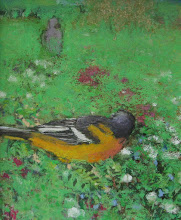middle August field
click on sketch to enlarge
 Field colors are leaving green. Each day shows more and more spent, drying, browning stalks and flower heads that are going to seed. There are blooms still and even some new blooms. Goldenrod is moving from green to gold. Joe Pye weed is becoming less carmine, dustier, dustier. Lemon-yellow blooms of late-year primroses bob, tall in the breezes. Queen Anne's lace is curling up everywhere, dunn-green, almost brown, almost ashy. But, still in the fields, also, some Queen Anne's lace is startlingly white, lacey, crisp. Around the blooms the greens are changing, frosting with mildew from humidity of the days and the nights' coolness or simply giving up, no more chlorophyll coming through: too much sun finally and night hours that are advancing.
Field colors are leaving green. Each day shows more and more spent, drying, browning stalks and flower heads that are going to seed. There are blooms still and even some new blooms. Goldenrod is moving from green to gold. Joe Pye weed is becoming less carmine, dustier, dustier. Lemon-yellow blooms of late-year primroses bob, tall in the breezes. Queen Anne's lace is curling up everywhere, dunn-green, almost brown, almost ashy. But, still in the fields, also, some Queen Anne's lace is startlingly white, lacey, crisp. Around the blooms the greens are changing, frosting with mildew from humidity of the days and the nights' coolness or simply giving up, no more chlorophyll coming through: too much sun finally and night hours that are advancing.goldenrod & primrose in the field
In these small paintings, I have the autumn colors underneath and starting to appear above the greens.
















